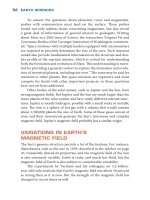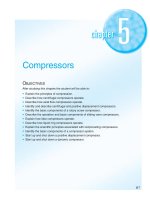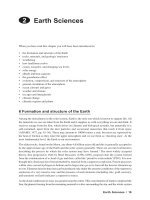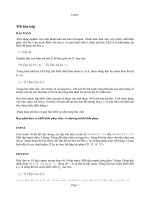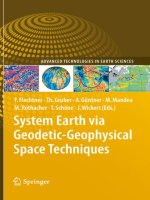- Trang chủ >>
- Khoa Học Tự Nhiên >>
- Vật lý
5 6 weather (earth sciences)
Bạn đang xem bản rút gọn của tài liệu. Xem và tải ngay bản đầy đủ của tài liệu tại đây (4.47 MB, 14 trang )
Earth Sciences
Standards
Preview
4.c. Students know the causes and
effects of different types of severe
weather.
Standard Set 4. Earth Sciences
4. Energy from the Sun heats Earth
unevenly, causing air movements that
result in changing weather patterns.
As a basis for understanding this
concept:
4.d. Students know how to use
weather maps and data to predict
local weather and know that weather
forecasts depend on many variables.
4.a. Students know uneven heating
of Earth causes air movements
(convection currents).
4.e. Students know that the Earth’s
atmosphere exerts a pressure that
decreases with distance above Earth’s
surface and that at any point it exerts
this pressure equally in all directions.
4.b. Students know the influence that
the ocean has on the weather and
the role that the water cycle plays in
weather patterns.
Genre
Nonfiction
Comprehension Skill
Draw Conclusions
Text Features
•
•
•
•
Captions
Labels
Charts
Glossary
Science Content
Weather
Scott Foresman Science 5.6
ISBN 0-328-23467-2
ì<(sk$m)=cdegh < +^-Ä-U-Ä-U
by Mary Imani
Vocabulary
air mass
anemometer
atmospheric pressure
barometer
convection current
cyclone
front
rain gauge
tempered
wind
Picture Credits
Illustration
6, 8, 23 Studio Liddell; 14 Tony Randazzo
Photographs
Every effort has been made to secure permission and provide appropriate credit for photographic material.
The publisher deeply regrets any omission and pledges to correct errors called to its attention in subsequent editions.
Unless otherwise acknowledged, all photographs are the copyright © of Dorling Kindersley, a division of Pearson.
Photo locators denoted as follows: Top (T), Center (C), Bottom (B), Left (L), Right (R), Background (Bkgd).
2 (R) ©Dorling Kindersley; 15 ©Japan Meteorological Agency
ISBN: 0-328-23467-2
Copyright © Pearson Education, Inc. All Rights Reserved. Printed in the United States of America.
This publication is protected by Copyright, and permission should be obtained from the publisher prior to any
prohibited reproduction, storage in a retrieval system, or transmission in any form by any means, electronic,
mechanical, photocopying, recording, or likewise. For information regarding permission(s), write to
Permissions Department, Scott Foresman, 1900 East Lake Avenue, Glenview, Illinois 60025.
1 2 3 4 5 6 7 8 9 10 V010 13 12 11 10 09 08 07 06
by Mary Imani
How does
air move?
Under Pressure
The air surrounding Earth
makes up the atmosphere. Look at
the diagram. Earth’s atmosphere
has several levels. Most weather
takes place in the lowest level. This
level is nearest Earth’s surface.
Atmospheric pressure,
or air pressure, is the weight of
air pushing down on an area.
Atmospheric pressure changes
as you go higher or lower in the
atmosphere. This is because there
are different amounts of air at each
level in the atmosphere. As you
go up, the pressure decreases. It
increases as you go down.
More About Atmospheric Pressure
Air pressure is lowest
at this level. The air
particles are farthest
apart.
Air pressure is lower
at this level. The air
particles can spread
farther apart. There is
less air above to push
them together.
Air is matter. Although it is invisible, it has mass and
takes up space. Gravity pulls air toward Earth’s surface. Air
has weight because of the pull of gravity. The weight of the
air causes air pressure.
Air particles are always moving in every direction.
As you move away from Earth’s surface, the air particles
become more spread out. This means that high up in
Earth’s atmosphere, air pressure is lower than it is at Earth’s
surface.
An altimeter measures air pressure to
give an object’s altitude.
Air pressure is highest
near the ground. The
weight of the air
above presses the air
near Earth’s surface
close together.
2
3
Convection Currents
Gas particles are closer together in cool air than in
warm air. This makes a difference in the weight of air. Cool
air is heavier than warm air.
The Sun heats Earth’s surface unevenly. This leads to
different air temperatures. Land heats up and cools off
faster than water. This causes the air over the land to have
a different temperature than air over the water.
Differences in air temperature cause
convection currents to form. Suppose
cool air and warm air are next to each
other. The heavier cool air will sink.
The lighter warm air will rise. A
convection current will be formed.
Rising air will cool. This
A convection current is the
cooled air is pushed
rising and sinking of matter in
over the water by the
rising air below it.
a circular pattern.
The cool water
won’t warm the
air above it as
much as the land
warms the air
above it.
As the diagram shows, wind is produced by convection
currents in the air. Wind is movement of air that happens
because of differences in air pressure caused by temperature
differences.
The kind of convection current shown in the diagram
occurs during the day. It forms near oceans and large lakes.
A different kind of convection current takes place at night.
It flows in the opposite direction.
The circular pattern of sinking cool air and rising warm
air repeats over and over. This pattern causes rain and
changes in air pressure. These circular air currents can even
cause the patterns you see in clouds.
Convection currents are not limited to the air. They
are also found in ocean water and the rocks deep beneath
Earth’s surface. The convection currents inside Earth move
heat toward the surface. In the oceans, convection currents
create ocean currents. The ocean currents, in turn, influence
different climates.
The warm land makes air above
it warm. This warm air is forced
up by the cool air.
As the cool air sinks
below the warm air,
wind is created.
4
5
Uneven Heating Due to Earth’s Tilt
Earth’s surface and atmosphere are heated by energy
from the Sun. But this heating is uneven. The uneven
heating leads to differences in air temperature. These
differences create Earth’s convection currents, which affect
weather and climate.
Near the poles, the
Sun’s rays are more
spread out.
Near the equator,
the Sun’s rays hit
more directly.
The
equator
Huge convection currents form
above Earth. They are created
when air masses with different
temperatures meet. These currents
shape wind patterns.
6
The North
Pole
Earth’s
axis
The South
Pole
Earth orbits the Sun. As it orbits, it also spins around its
axis. Earth’s axis is tilted at an angle of about 23.5°. This
tilt has a huge effect.
Because of the tilt, the Sun’s rays hit some regions on
Earth more directly than others. Near the equator, the Sun
is always high in the sky. The Sun’s rays hit these regions at
a direct angle. Near the poles, the Sun is always low in the
sky. The Sun’s rays hit these regions at a less direct angle.
How do you think the angle at which the Sun’s rays
strike the equator and poles affects these regions’ weather?
Check your answer by reading the captions in the diagram.
7
What are air masses?
Kinds of Air Masses
Sometimes air will stay over an area for a period of
time. As it does, it takes on the properties of that area.
If the air stays long enough, it becomes an air mass. An
air mass is a large body of air with similar properties
all through it. The two most important properties are
temperature and the amount of water vapor. The weather
your area experiences usually depends on the air masses
that are above it. There is some weather that happens only
along the edges of air masses.
Air masses move because of winds near or far above the
ground. The jet stream is a strong wind, high above Earth.
It can move cold, dry air from Canada to the United States.
Cooler air forces warmer air
to move up quickly.
There are four basic kinds of air masses. They are
named for the areas where they form. Maritime polar
air masses form over the oceans near the poles. These air
masses are cold and fairly moist. Continental tropical air
masses form over large hot deserts. The air in them is warm
and dry. Maritime tropical air masses form over tropical
oceans or rain forests. They are warm and very humid,
containing a lot of evaporated water. Finally, continental
polar air masses are made over the land and ice at the
poles. This air is cold and dry.
When Air Masses Meet
A front is a boundary between two air masses. There
are cold fronts, warm fronts, and stationary fronts. Colder
air is brought into an area by cold fronts. Warmer air is
brought into an area by warm fronts. A stationary front
moves very slowly or not at all.
Warmer air gradually
rises above the cooler air.
Cold Front
Warm Front
Cold air
Warm air
Warm air
Cold air
8
9
Highs and Lows
Cyclones
Have you ever noticed the letters H and L on a weather
map? The H shows where there is high pressure. The L
shows where there is low pressure. Wind flows from areas of
higher pressure to areas of lower pressure.
Atmospheric pressure is affected by air temperature. Air
that is cool is heavier. It is under higher pressure than the
same volume of warmer air. Air that is warm is lighter. It is
under lower pressure than cooler air.
Fair weather is usually brought in by areas of high
pressure. Cloudy and stormy weather often comes with
areas of low pressure. Low-pressure systems may also bring
rain or snow.
High-pressure air wraps around warm, low-pressure air.
The high pressure makes the warm air in the center rise. As
the air rises, the surrounding high–pressure air flows in to
take its place. This flow of air forms a wind called a cyclone.
The cyclone spirals inward and forms a weather system. In
other words, it moves in a spiral.
Earth’s rotation causes cyclone winds to spin
counterclockwise in the United States. South of the equator,
cyclone winds flow in a clockwise direction.
Stormy weather is usually found near cyclones. A
hurricane is a severe form of a cyclone.
Anticyclones spin clockwise north of the equator, in the
opposite direction of cyclones. They usually cause clear
weather.
Anticyclone
Cyclone
In the United States, cyclone
winds spin counterclockwise.
10
11
What causes severe
weather?
Thunderstorms
The pictures on this page show how a thunderstorm
can form. In the first stage, strong currents of moist air
rise. Water condenses, building clouds in the rising air. The
clouds are made up of ice crystals and water droplets. In
the second stage, precipitation starts to fall. This pulls some
air downward as other air currents rise. In the storm’s last
stage, all the air moves downward. Precipitation leaves the
clouds. Note that two parts of the water cycle, condensation
and precipitation, are involved in thunderstorms.
+ +
+
+ + ++ + +
+ +
++
+
– –– – –
– ––
–
Different areas of a
thunderstorm cloud have
positive or negative charges.
The cloud’s negative charges
cause positive charges to
gather on the ground.
+ +
+ + +
+ +
++
+
First stage:
All air currents
move upward.
12
Second stage:
Air currents are
mixed.
Final stage:
All air
currents move
downward.
13
Tornadoes
Hurricanes
Some thunderstorms can produce tornadoes. A tornado
is a violently rotating column of air. It reaches from a
thunderstorm to the ground.
Tornadoes move fast. The winds inside of them travel at
hundreds of kilometers per hour. Tornado winds can throw
cars around. They can severely damage buildings.
Take cover right away if you hear a tornado warning
on the radio or television. If you can, go to a basement.
Otherwise, go to a closet. You can also take shelter in a
windowless room in the center of a building.
Hurricanes are ocean storms. They get their energy from
warm ocean water. How?
Remember, water vapor from the ocean condenses
during the water cycle. When water vapor condenses,
it gives off heat. If conditions are right, the heat energy
builds. It gets strong enough to drive hurricane winds.
Hurricanes are very severe storms. They can be
hundreds of kilometers wide and hit several countries.
Hurricanes last for days. They produce huge waves, which
pound the shores and can cause floods. Heavy rains from a
hurricane can also produce floods far inland.
Before tornadoes form, winds change
direction and increase in speed.
Winds begin to spin.
Thunderstorms grow out of a
tropical depression.
As the tornado forms, air within it
rises. The spinning air begins to tilt
upward.
Air pressure at the ocean’s surface
drops. Surface winds blow faster
and begin to swirl. A tropical storm
develops.
The spinning area grows wider.
Thunderstorms begin to move in spiral
bands. Air pressure drops lower, and
surface winds blow faster. The tropical
storm is now a hurricane.
14
15
Ocean Temperature Affects Weather
Monsoons
Changes in the ocean’s temperature can cause large
changes in weather. El Niño is a warming of the eastern
Pacific Ocean near the equator that takes place every 4
to 12 years. This change can cause very wet and very dry
seasons in many parts of the world.
As you know, land heats and cools more quickly than
water. This means air above land heats and cools more
quickly than air above water. Large bodies of water, such as
oceans, can affect air temperature. The air above oceans is
tempered. It is warmed in winter and cooled in summer.
Remember that in the United States, winds and weather
usually flow from west to east. But in some parts of the
world, wind direction changes with the seasons. A monsoon
is a wind that changes directions with the seasons.
Monsoons are common in south and southeastern Asia.
Asia’s winter monsoons form when land temperatures
become colder than ocean temperatures. The colder land
temperatures cause areas of high pressure to form. Wind
flows from these areas to the lower pressure areas over the
ocean. Because the land air is dry, the winter monsoon
brings little rain.
Very heavy rains fall during the
summer monsoon season.
16
17
How are weather
forecasts made?
Collecting Data
To fully describe the weather, you must describe
all its parts. The most important weather features are
temperature, moisture, clouds, precipitation, wind speed, air
pressure, and wind direction. All these parts may interact
with one another. They may also change completely in a
very short time.
Rain Gauge
Many weather instruments measure the changing parts
of the weather, called variables. A barometer shows air
pressure. Some barometers work by having air pressure
raise and lower an amount of mercury inside of a tube. A
hygrometer measures the amount of evaporated water in
the air. The length of its horsehair tells how humid it is.
An anemometer measures wind speed. A rain gauge
measures how much rain has fallen.
Doppler radar can measure the winds and precipitation
inside a storm. The radar sends out energy. Some of the
energy bounces off storm parts, such as raindrops, and
returns to the radar. The returning energy shows the
raindrops’ direction and speed.
Doppler radar is an important new weather
technology. It is used to find “ordinary”
storms and track their motion. It is also
used to track tornadoes.
Barometer
Anemometer
18
19
Technology Helps Weather Forecasters
Weather Patterns in Forecasting
A weather forecaster is a person who reports on and
predicts weather. To make predictions, forecasters use
observations of past and present weather.
Weather follows patterns. Temperatures rise during the
day. They fall at night. Temperature also changes as the
seasons change. Precipitation may change with the seasons
as well. Rain may fall in spring. Snow may fall in winter.
Forecasters use weather patterns to make predictions. They
assume that future weather will follow past weather. Weather
forecasters try to compare as much data on past and present
weather as possible. The more information they have to
compare, the more likely they will make better predictions.
Weather Instrument Technology
Accurate weather forecasting began with the invention
of the telegraph. The telegraph allowed forecasters to quickly
send out information about the weather. In 1927, the first
weather balloon was sent into the atmosphere. Weather
balloons carry instruments that measure air conditions.
They send information back to receivers on the
ground.
Satellites are important for weather
forecasting. Satellites orbit Earth. This means
they are always moving. Satellites can
supply weather data for all parts of Earth.
Contrast this with a weather station, which
Weather
satellite
can only give weather data for one area.
Satellites can show where clouds are. They
can form pictures showing the temperature
at different places on Earth. Satellites
can even show how much water
vapor is in the air!
Weather Maps
Look at the map. The lines showing fronts give us a lot
of information about the weather. The lines’ triangles or
half circles show the direction in which a front is moving.
Warm weather moves in when a warm front passes over.
Cold weather arrives when a cold front pushes through.
A weather map often shows air
pressure, fronts, and precipitation.
Scientists called
meteorologists use data
from weather stations,
radar, and satellites to
forecast the weather.
20
21
Satellite and Radar Maps
Weather forecasters rely on many kinds of maps. Some
maps show today’s weather conditions. Other maps show
what weather lies ahead.
One type of map is made using satellite pictures that
show where clouds are. The pictures of clouds can be shown
over a map of the United States. Then people can see, for
example, if there are clouds over San Francisco Bay.
High-speed computers make most of the maps that
weather forecasters use. Computers analyze and map
weather data from Doppler radar. They process the data
fast enough to give us a picture of how the weather is
changing moment by moment. This speedy technology is
very useful in forecasting severe weather.
–7°C
–1°C
4°C
10°C
This weather map shows
air temperature.
16°C
21°C
27°C
32°C
Common Weather
Symbols
Area of high
air pressure
Area of low air
pressure
Warm front
Cold front
Stationary
front
Snow
A Doppler radar map can show
California’s weather conditions in
real time.
This legend explains
the symbols and
colors used on some
weather maps.
Rain
Thunderstorms
Sunny
Cloudy
22
Partly cloudy
23
Glossary
air mass
a large body of air with similar
properties all through it
anemometer
a tool that measures wind speed
atmospheric pressure
the weight of air pushing down
on an area
barometer
a tool that measures air pressure
convection current
the rising and sinking of matter
in a circular pattern caused by
temperature differences
cyclone
a wind that spirals inward
around an area of low pressure
front
a boundary between two air
masses
rain gauge
a tool that measures the
amount of rain that has fallen
tempered
describes air that is warmed in
winter and cooled in summer
because it is near a large body
of water
wind
convection currents in the
atmosphere
24
What did you learn?
1. What happens to air pressure as you move higher above Earth’s
surface?
2. What are four types of severe weather?
3. How can you tell on a weather map the direction in which a front
is moving?
4.
Suppose you live in a farming village in
Southeast Asia. Write a couple of paragraphs that describe what
happens during the summer monsoon. Write an ending telling
how the monsoon affects you.
5.
Draw Conclusions Suppose you see a TV weather forecaster
announce that high-pressure air has surrounded warm air under
low pressure in your area. Draw a conclusion about the weather
this might bring.
